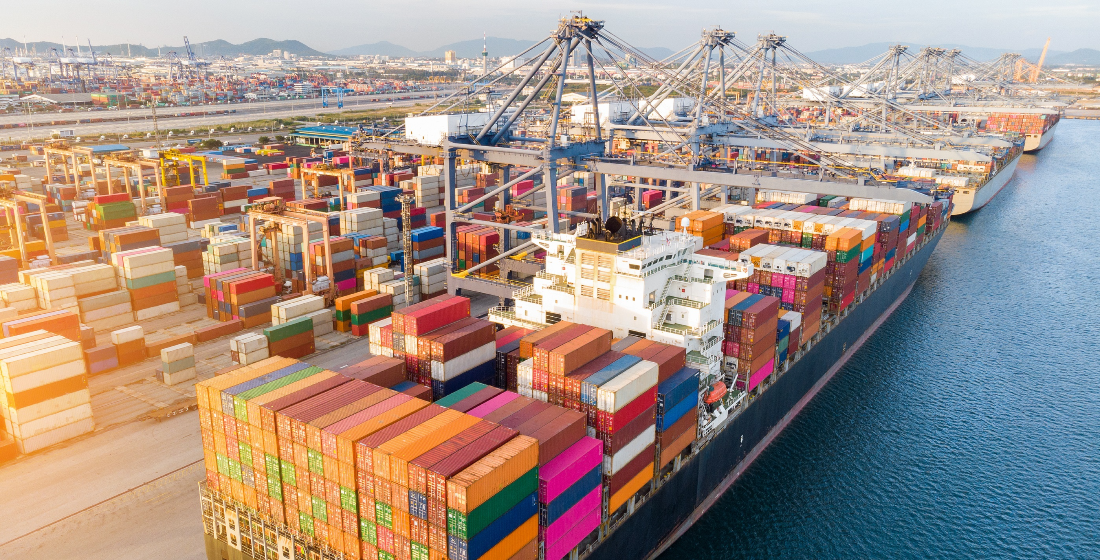Fragmented world set to alter global trade supply chains
War and geopolitical tensions are accelerating the move from globalisation to a much more fragmented world, which in turn is changing the patterns of global trade.

Through the Covid pandemic global trade supply chains were shot to pieces largely because of the logistics of availability of containers, vessels and of course ports being open and able to handle the volume of traffic. And that was just seaborne activity – the situation was multiplied with international road and rail haulage as well as air freight disruption. Naturally, the consequences of all this led to a rethink for many in terms of not only where they sourced particular goods and commodities, but how much stock they carried.
On top of this, the world had already begun a move away from intense globalisation, and this was spurred along by politicians such as Trump banging on about ‘make America great again’, and the UK going down the tunnel of Brexit! Now, we see the horrors of the actions of the despot Putin invading Ukraine, and waging war, death and destruction in that country. Perversely, much of the global South, and certain other nations, seem to think this is almost acceptable while some also seek to benefit from discounted Russian oil & gas, grain and favours. Rant over.
And at the same time a number of political and strategic alliances are being redrawn, leading to a much more fragmented global order. But that changing global order is likely to continue, particularly as the US and China continue to square up for technological global dominance.
So, it brings me to the essence of this blog, which is to take a quick look at two recent global/regional trade reports which reveal in some considerable detail just how our world is becoming more geopolitically sensitive, fragmented, and how consequently global trade supply chains are in a state of flux.
Last week the ICC published its ‘2023 Trade Report, A fragmenting world’. The ICC report includes: an analysis of the recent trends in trade; global trade forecasts for 2023; an overview of fragmentation trends in fields including trade, digital economy, debt, and payment systems; and an assessment of the recent rise in protectionist measures.
And in February, HSBC Asia-Pacific released its latest report ‘Global Supply Chains – Networks of Tomorrow: Navigating the Future of Trade’. According to the report, among other trends, over the next 12-24 months corporates in Asia-Pacific are looking to move more of their supply chains closer to home. The research notes that corporates will base more than half (53%) of their supply network in Asia, up by nearly 6% from 2020.
A fragmenting world
The ICC 2023 Trade Report, A fragmenting world, puts forward sound reasoning that companies need to be increasingly aware of the changes taking place in order to be ahead of the game, noting: “Despite growing concerns, globalisation has not reversed but is changing. There is evidence of increasing economic fragmentation or decoupling. These shifts – which could influence investment and trade decisions in the years ahead – present several risks for businesses and could reap the benefits of globalisation. It is critical for policymakers and businesses to grasp this changing context and anticipate these risks.”
The first chapter of the report describes the 2022 trends in trade in merchandise and services. The second chapter presents the outlook for the present year underlining the fragmenting forces at play. Finally, the third chapter analyses the fragmentation trends in different fields including trade, digital economy, debt and payment.
Looking at some of the main messages, the report notes:
Trends in 2022: A trade rebound disrupted by multiple shocks
- Trade rebounded but was disrupted by the war in Ukraine, lingering Covid-19 restrictions, persistent high inflation and lower economic growth.
- Globalisation is not gone but changing patterns.
- There is evidence of decoupling between China and the United States (US) but also Russia and Western countries.
Outlook for 2023: Trade growth will face strong headwinds
- Geopolitical tensions will continue to shape supply chains and trade dynamics.
- Businesses are already adjusting their inventory strategy and diversify their suppliers.
Challenges: Fragmentation is accelerating
- The rise of subsidies, export controls and investment restrictions are contributing to trade fragmentation.
- Digital fragmentation is both driving and mirroring geopolitical tensions.
- Debt fragmentation could lead to a debt crisis.
- Payment fragmentation could increase instability and erode the role of the US dollar.
- The cost of fragmentation could range from 1.2% to 12% of global GDP.
On the issues of decoupling the report emphasises: “Since 2018, talk of the US ‘decoupling’ from China has picked up. Although US imports from China in 2022 reached their highest level since 2018, the share of China in total imports declined from 22% in 2017 to 17% in 2022. US exports to China declined from 8% to 7%. Meanwhile, the share of China’s exports to the US dropped from 19% to 16% in the same time period. Imports from the US slightly decreased from 8% to 7%. A similar negative trend was observed for foreign direct investments. Lastly, China significantly reduced its interaction with the US in scientific collaborations.”
The report also highlights: “As a result of the war in Ukraine, Europe is decoupling from Russia in the energy sector. Between February 2022 and December 2022, the value of EU imports from Russia fell by 51%. Between 2021 and 2022, extra-EU imports of energy products from Russia fell strongly, for example, coal (from 45 to 22%), natural gas (from 36% to 21%), and petroleum oil (from 28% to 21%). Russia turned to eastern markets to compensate for the loss of European demand. Indeed, imports from Russia to China (73%), Turkey (153%) and India (430%) significantly increased in 2022.”
As far as fragmentation is concerned, the report examines trade fragmentation, where it notes: “Globalisation, already slowing, is further deteriorating. Trade tensions, the pandemic and the war in Ukraine have led to a rise in protectionist measures. They include subsidies, export controls and investment restrictions and contribute to trade fragmentation.” And it asserts that globalisation has become slowbalisation. However, I’m not entirely sure whether this is a term that will really catch on.
Importantly the report examines closely the various elements of digital fragmentation, debt fragmentation and payment fragmentation.
And on the issue of debt fragmentation, it states: “The geopolitical tensions are hindering debt restructuring negotiations. As evidenced by the current situation, fragmentation makes it harder to resolve sovereign debt crises. The US is blaming China for holding up debt restructuring negotiations in Sri Lanka and Zambia while China wants multilateral lenders to share the pain of debt restructuring by agreeing on unprecedented ‘haircuts’ on their loans. However, the World Bank and other multilateral lenders have rejected that proposal as they suffered losses during the debt forgiveness round in the early 2000s. As a result, both the Sri Lankan and Zambian economies are stuck in profound economic crises, waiting for an IMF bailout.”
And on the issue of the overall cost of fragmentation the ICC report emphasises: “The global cost of fragmentation increases with the degree of fragmentation, that is, the number of sectors and countries affected. The costs would include higher import prices, segmented markets and diminished access to technology, among others. According to several studies, the global cost could range from 1.2% to 12% of global output. The latter is equivalent to the output of Germany and Japan. By restraining spillovers, technological decoupling would be the most costly, especially for emerging and low-income countries. Countries from the Asia-Pacific region would heavily suffer from fragmentation as they are trade-intensive.”
The ICC report is available here.
Global Supply Chains – Networks of Tomorrow
The HSBC Asia-Pacific research report - Global Supply Chains – Networks of Tomorrow’ - stresses that as supply chains shift in response to ever-changing factors, including the entry into force of the Regional Comprehensive Economic Partnership (RCEP), the trend for APAC corporates to move their supply chains closer to home is becoming more apparent.
Commenting on the findings of the research: Aditya Gahlaut, co-head of global trade and receivables finance, Asia-Pacific, HSBC, comments: “Companies in Asia-Pacific have begun to realign their supply chains to capitalise on the advantages offered by RCEP. RCEP harmonises the rules of origin across much of the region, lowering the cost of inputs for manufacturers and making their goods more price-competitive. At the same time, it provides greater access to larger markets for exporters, spurring investment within RCEP and from beyond.”
The research report is now in its third year, and for the current report the bank 450 corporates across Asia Pacific between August and October 2022, in order to determine the push and pull factors affecting how – and where – corporates trade. While the research was APAC-focused the last two years, this year the scope was expanded to include non-APAC markets such as Germany, Mexico, UAE, the UK and the US.
The research revealed that at a time when supply chain resilience is increasingly heard on earnings calls, 67% of APAC corporates are looking to reduce their number of suppliers, up by a whopping 20% from 2020.
“It may seem counterintuitive – if a company faced supply disruptions in the past, you would think it would want to work with more suppliers,” continues Gahlaut. “But it makes sense for companies to secure their sourcing from fewer suppliers while cultivating longer-term, more strategic relationships with them.”
Gahlaut also adds: “Geographic diversification is an important consideration when designing more resilient supply chains.”
As other reports have found, the research also reveals that disruptions to global supply chains and the resulting logistical challenges have caused just-in-time inventory management to give way to just-in-case. Nearly 78% of APAC corporates have held excess stock over the last two years, with an average increase of 36% in inventory.
Gahlaut concludes: “The model of having everything arrive just in time is unlikely to come back entirely. A topic that corporates are increasingly discussing is the need to get the balance right between stocking up for just-in-case scenarios and the cost of doing so.”
As corporates continue to make changes to their supply chains, product quality (83%) and cost (78%) are the runaway factors when deciding on suppliers for APAC corporates. Rounding out the top five are payment terms (52%), ease of digital integration (27%) and ESG credentials (26%).
The report can be downloaded here.
Become a subscriber today for unrestricted access to the best export, trade and commodity finance analysis available.
Click here for information on the different packages available for you and your team
Exclusive subscriber-only content published last week:
OECD announces landmark modernisation package for the Arrangement on export credits
The OECD reform package of the Arrangement on export credits will be a complete game changer for the export finance sector.
Mandates with destiny - Does export finance need a bigger bucket?
Rebecca Harding, Rebeccanomics; Gabriel Buck, GKB Ventures; and Chris Mitman, Investec and Acre Impact Capital, discuss the flow of deals and projects in export finance.
The Commodity Trade Finance Industry Report 2022: A sneak peek
TXF’s annual Commodity Industry Report showcases an independent, thorough, and exclusive exploration of some of the key trends in the industry over the past year.
Ras Ghareb wind financing priced
Sponsors of the $660 million 500MW Ras Ghareb wind farm in Egypt have reached financial close on the non-recourse debt backing the scheme.
Doga Yildizci hired as global head of STF at Viterra
Doga Yildizci has been hired as global head of structured trade finance at international grain trading company Viterra.
Nick Halkas promoted to head of metals & mining Asia at SMBC
Nick Halkas has been promoted to head of metals & mining Asia-Pacific at SMBC in Singapore.
Cat Rosales appointed as export finance director at Barclays
Cat Rosales has been appointed as a director within the export finance department at Barclays Bank.
Sabine Oudart moves to CACIB as head of receivables and SCF
Sabine Oudart moves back to Europe to work for CACIB as head of trade receivables and supply chain finance.
IFC mulls $400m loan for Banco BBVA Peru
IFC is considering a six-year, senior unsecured loan of up to $400 million for Banco BBVA Peru to expand the bank’s green building loan portfolio.
IFC loan proposed for Sanasa’s wastewater CAPEX in Brazil
IFC is mulling a loan of up to $50 million to Sociedade de Abastecimento de Agua e Saneamento (Sanasa) in Brazil.





